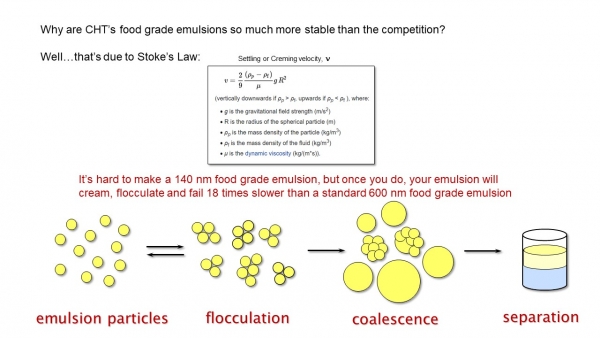Promotional Features
The holy grail of emulsions: precision-made, silicone-based solutions designed to keep lines moving
Pete LeBaron, Global Head of Technical Service & Development Industrial Production at CHT, explains why using customized silicone-based antifoams and emulsions on your production line is one of the best investments you can make.
Tell us about emulsions in food processing lines
Silicone emulsions are commonly used on food packaging assembly lines to provide a low coefficient of friction for faster processing and antistatic properties on plastic food containers which prevents them from sticking together. The goal of a silicone additive is to prevent these thermoformed products from sticking together or ‘nesting’ during the high throughput processing – that’s why the application is sometimes referred to as ‘de-nesting’ or ‘anti-nesting’. A few examples include transparent takeout food packages, fast food salads and small containers for sauces or dressings. Silicone-based emulsions have a clear advantage in this application because they are food grade, provide good slip and have ultralow surface tension, so a little bit goes a long way.
Silicone… Is that a plastic?
Silicone originates from sand and has the same amazing, super strong siloxane bond in its backbone. The Si-O bond is everywhere on Earth – it is largely UV invisible and stable through a wide temperature range, making it one of the strongest, most inert bonds in the world. In fact, around 90% of all minerals in the Earth's crust contain silicon-oxygen bonds. Oil and wax-based emulsions, on the other hand, are made up of hydrocarbons with more easily degraded carbon-carbon and carbon-hydrogen bonds and these can fail during processing due to oxidation and mass loss.
What’s the advantage of silicone in an emulsion?
There are many. Silicone will give you a long-lasting, even product coating because it’s not soluble in water and has a lower surface tension than all polymers except fluorine-containing organics. When silicone finds an interface, such as food container, it will tend to immediately form an ultrathin coating and stay put through processing.
Another huge advantage is silicone's utility in diverse systems, like hot and cold or sprayed versus dipped systems. Unlike an organic polymer or hydrocarbon oils or waxes, silicone’s properties remain consistent over a wide temperature range. Surface tension and viscosity remains very similar when exposed to boiling water or even higher temperatures, and all the way down to freezing conditions. Hydrocarbons go through dramatic changes in physical properties over the same span of conditions, and that can cause the coating to be not as uniform.
The initial outlay of silicone-based emulsions can seem higher on a per pound basis than a substitute emulsion but because you get ultra-high dilution effectiveness, a little silicone goes an extremely long way – it's best to compare a food-based coating or antifoam on a per pound used, not per pound bought. We’ve had customers who were able to use 40 times less silicone as they were hydrocarbons to get the same slip and release properties.
Is silicone safe to use in food?
The silicone polymer is very benign with hypoallergenic and bio-inert properties and has all the necessary food-grade approvals from the FDA (Food and Drug Administration) for direct and indirect contact with food – not many synthetic polymers have this level of regulatory approvals. Governing bodies around the world have approved silicone for medical use which a lot of folks new to silicones don’t realize. There are lots of other polymers that could function in these food applications, including PFAS (Perfluoroalkyl and Polyfluoroalkyl Substances) materials, but silicone is a more environmentally sustainable material which is why it continues to displace other chemistries of concern in everything from fast food packaging to French fry defoaming to vegetable washing and even anti-gas drops for infants.
Are all silicone-based emulsions made equal?
No, not by a long shot. Emulsions are made up of surfactant-stabilized particles in water, and particle size is a key factor in determining how an emulsion behaves. By manipulating the particles, and sometimes the continuous phases, we can change the way that the emulsion behaves on a production line. That's why customers come to us at CHT – we can create a precision-made emulsion that’s customized for a specific set of requirements which ultimately means that their production line runs smoothly and efficiently. Some folks want 0.5% solids stability of a silicone emulsion for several working shifts, while others want immediate break out in a dip coating process. We are experts in customizing silicone emulsions to suit these and many other highly particular, intricate applications.
What about antifoams – are these a type of emulsion?
Antifoams for food are generally referred to as dispersions in water and are indeed technically emulsions. But they tend to be a bit more rudimentary in particle size distribution compared to some of the high-end food grade emulsions that we produce. Since the antifoam compound and surfactants permitted for food use are quite limited, there can be less knobs to turn when following the FDA guidelines and producing a food grade antifoam made from silicone. Our labs have still found good utility in customizing how these antifoams, typically at 5-30% solids, are put together to produce a product that performs exactly as the customer needs. Customization is what we do – people often ask us for a thinner or thicker version of an antifoam they’ve bought off the shelf or for one that acts faster or lasts longer. Those are the requests that I love, because most often we can make exactly what our customers want.
When might an antifoam be used?
As its name suggests, antifoams keep the foam and suds down so that an assembly line keeps producing. Nobody wants foam, and silicone antifoams are all about improving a manufacturer’s throughput by eliminating downtime. Food grade antifoams are used in everything from food handling, processing and washing, mostly upstream in the assembly line where agitation, contact with air and food-grade detergents are used. We also make antifoams that are added during processing but remain active and benefit the final packaging and bottling stage – for example where there is a foaming issue which stops lids from closing easily. By using controlled dilutions of our product upstream, at say 5, 10, 20 parts per million, dependent upon the conditions, these products can be tuned to consistently deliver the right foam control.
What about anhydrous systems?
Silicone antifoams are very user friendly. While most of our customers use them in water-based systems, we do have food producing customers who are trying to defoam something like cooking oil or other water-free food mixtures. In this case we produce specialized oil-dispersible silicone antifoams that still find that air-liquid interface and effectively kill foam. If you read the back label of the top selling aerosolized cooking oil sprays, you’ll find silicone listed, and that’s there to control foam. We do this type of defoaming at a large scale with several of our food processing customers.
Sounds like silicone-based antifoams are something food manufacturers need to stock up on…
Well yes – and no! Because our antifoams have such high effectiveness at low dilutions, they take up much less storage space than a non-silicone antifoam. We had a customer who moved from hydrocarbons to our silicone emulsion and they were able to cut their antifoam use down by 50 times! As I often say, a little silicone goes a long way and for this reason it really is an amazingly sustainable, energy and time-saving polymer for the food processing industry.
How do you test a new product?
We manufacture from the ground up and co-develop a specialized product hand-in-hand with our customers. Ideally our lab experts receive the exact troublesome foaming system from the customer, and we then carry out antifoaming tests on that system. All applications vary, so while this route is best, we have enough experience to select something close to get started if the customer is unable to send us their mix. We pride ourselves on speed and like to get a potential solution in the customer's hands as quickly as possible to see if we are heading in the right direction. The most common feedback I hear from customers working with our lab is that for finding customized food solutions, they are the fastest and best in the business.
What’s your favorite part of the job?
I'm fortunate in that I love talking silicones and solving problems and for most of my day that's exactly what I get to do with our customers. Specifically in the food industry it seems that each customer has their own refined process. An existing emulsion might work for 20 lines but needs to be modified to work in a different system. Take potatoes – everyone has to wash potatoes but when you go to each washing station, one might spray overhead with large nozzles, others might first submerge and clean with forced air, whereas another first tumbles them in soapy water. So the agitation and aeration varies, and the nozzles can be completely different, too. The devil’s in the details, especially in the food industry, so when you get down to the nitty gritty there are multiple variables and unique processes involved. And this provides a near infinite continuum for customization. When a customer calls up with a technical question about a very specific problem on their processing line, and I know that CHT has a silicone solution that can solve it, that is definitely the favorite part of my day.
To find out how your business can benefit from silicone-based emulsions and antifoams, email vaqhfgevny.fvyvpbarf@pug.pbz.


